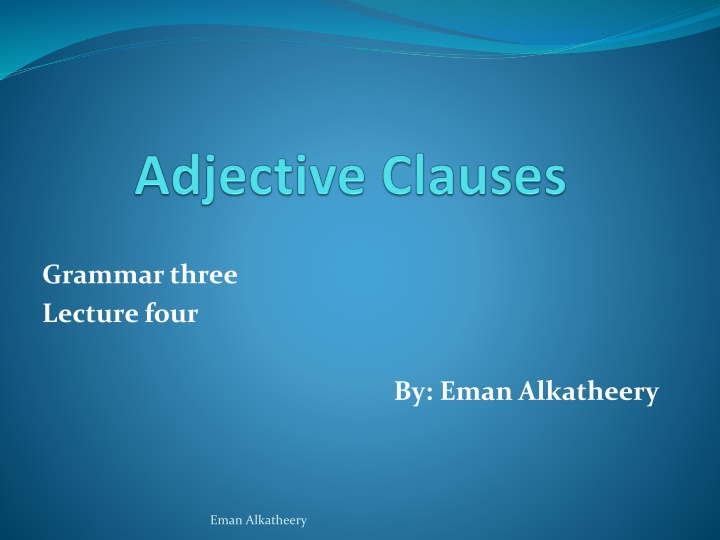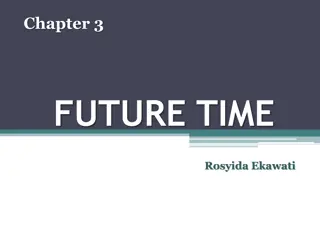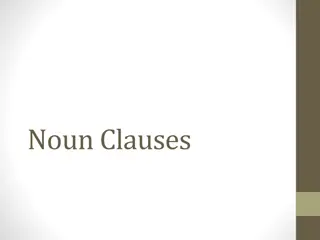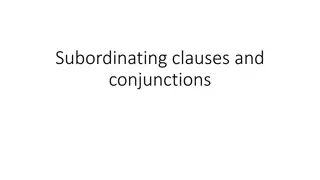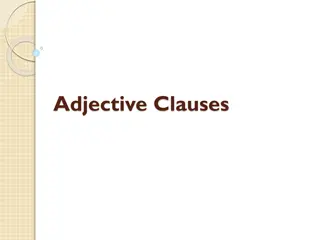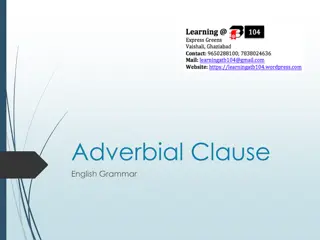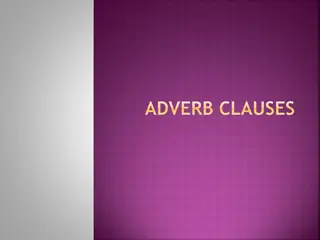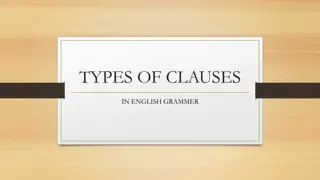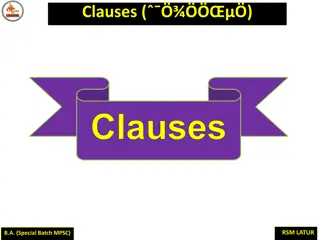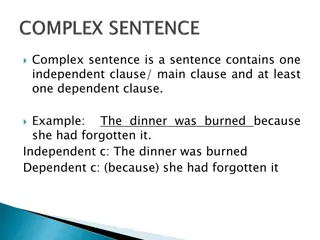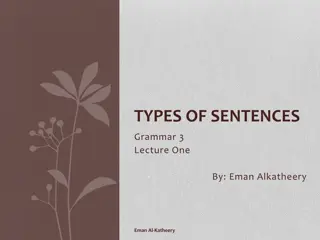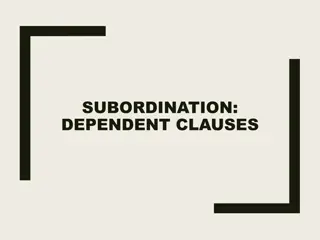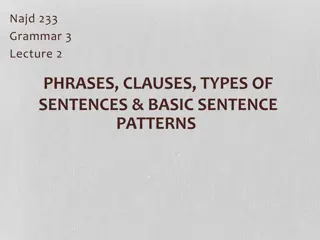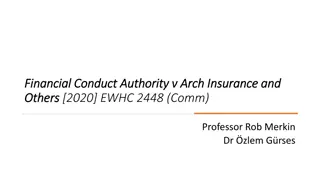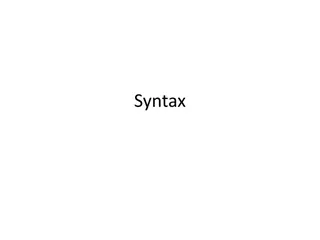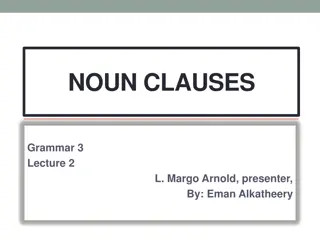Adjective Clauses: Types, Examples & Usage
Learn about adjective clauses, including restrictive vs. nonrestrictive clauses, types of relative pronouns, and examples to enhance your understanding. Explore how commas are used and the different functions of adjective clauses in sentences.
Download Presentation

Please find below an Image/Link to download the presentation.
The content on the website is provided AS IS for your information and personal use only. It may not be sold, licensed, or shared on other websites without obtaining consent from the author.If you encounter any issues during the download, it is possible that the publisher has removed the file from their server.
You are allowed to download the files provided on this website for personal or commercial use, subject to the condition that they are used lawfully. All files are the property of their respective owners.
The content on the website is provided AS IS for your information and personal use only. It may not be sold, licensed, or shared on other websites without obtaining consent from the author.
E N D
Presentation Transcript
Grammar three Lecture four By: Eman Alkatheery Eman Alkatheery
Part One Adjective Clauses: Restrictive Clauses versus Nonrestrictive Clauses Eman Alkatheery
Adjective Clauses An adjective (or relative) clause is a dependent clause that adjective in a sentence. It modifies nouns, pronouns, or a whole sentence. It begins with a relative pronoun. It comes immediately after the words that it modifies. In some cases, a prepositional phrase may come in between. functions as an Eman Alkatheery
Adjective Clauses Examples: The first football world cup ,which took place in 1930, was held in Uruguay. I have not read the magazine that is lying on the table. People who use microwave ovens save time and money. Ovens that use microwave energy cook food quickly. The award that Mario received was for his volunteer work. Eman Alkatheery
Adjective Clauses There are several types of adjective clauses (Table 4.1, p. 156) Typesof Clauses Relative Pronoun Example Subject That, which, who Biology is a subject that is very interesting. That, which, who (m) Object It is a subject which I would like to study. Dr. Smith, whoseclass meets today, is an expert. possessive whose Eman Alkatheery
Adjective Clauses Types of Clauses Relative Pronouns example place Where I remember the caf where we met. Does the class meet at a time when you can attend? Time When Quantity + of + which or whom I saw three movies, one of which was boring. quantity Eman Alkatheery
Adjective Clauses Biology is a subject that is very interesting. Biology is a subject. + Biology is very interesting It is a subject which I would like to study. It is a subject. + I would like to study the subject. Dr. Smith, whose class meets today, is an expert. Dr. Smith is an expert. + His class meets today. Eman Alkatheery
Adjective Clauses Adjective clauses are divided into two types: 1. Restrictive clauses 2. Nonrestrictive clauses The type of the adjective clause determines the use of commas. Commas are only used with nonrestrictive clauses. Eman Alkatheery
Adjective Clauses Restrictive clauses (Table 4.2, p. 157) It explains which people, places, or things: not everything or everyone. It limits the noun or pronoun that it modifies to only what is described in the clause. No commas are used. The relative pronoun (that) is only used with restrictive clauses. Eman Alkatheery
Adjective Clauses Example: Men who are not married are called bachelors. The students who passed the exam will take the next level. There is only one museum that is open on Sundays. Eman Alkatheery
Adjective Clauses Nonrestrictive clauses (Table 4.2, p. 157) It does not define or limit the noun or pronoun that it modifies. It only adds more information about the word it modifies. It does not explain which people or which things. Nonrestrictive adjective clauses usually modify proper names, nouns that are unique, and nouns preceded by demonstratives. Eman Alkatheery
Adjective Clauses Examples: Professor Jones, who teaches my biology class, won a Nobel prize. We visited this pyramid, which is located in Cairo. The moon, which appears in many ancient drawings, was an ancient symbol of fertility. Eman Alkatheery
Adjective Clauses Compare: Professor Jones, who teaches my biology class, won a Nobel prize. The professor who teaches my biology class won a Nobel prize. Eman Alkatheery
Clauses with Multiple meanings In some cases, a particular clause can be either restrictive or nonrestrictive. (Table 4.3, P. 157) It can either identify or give extra information. The adjective clause type can be identified by: 1. The speaker s or writer s point of view 2. Punctuation ( commas) Eman Alkatheery
Clauses with Multiple meanings COMPARE: My sister who lives in Jeddah teaches in a high school. My sister ,who lives in Jeddah, teaches in a high school. Practice 1, P. 158 Practice 2, P. 159 Practice 3, P. 161 Eman Alkatheery
Clauses with Multiple meanings Compare: The teacher thanked the students who brought her flowers. The teacher thanked the students, who brought her flowers. The teacher pointed at the maps which are located at the back of the classroom. The teacher pointed at the maps, which are located at the back of the classroom. Eman Alkatheery
Part Two Adjective Clauses: Replacement of Subjects Eman Alkatheery
Clauses with who, that , and which A sentence with an adjective clause can be seen as a combination of two sentences. The relative pronouns who, which, and that may replace the subject of a simple sentence in order to form an adjective clause (Table 4.4., P. 163) John is a doctor. + John, who is a doctor, works hard. John works hard. Eman Alkatheery
Clauses with who, that , and which In restrictive clauses, who and that refer to people, but who is preferred. Which and that refer to animals and things, but that is preferred. In nonrestrictive clauses, only who and which are used. That is not possible. Eman Alkatheery
Clauses with who, that , and which The man was named Stephens. The man found the ruins. The man who found the ruins was named Stephens. The house is expensive. The house is in the 7thstreet. The house that is in the 7thstreet is expensive. Eman Alkatheery
Clauses with who, that , and which Shakespeare wrote more than 100 sonnets. Shakespeare is a famous English poet. Shakespeare, who is a famous English poet, wrote more than 100 sonnets. Toronto is a beautiful place. Toronto is the largest city in Canada. Toronto , which is the largest city in Canada, is a beautiful place. Practice 1, P. 163 Eman Alkatheery
Clauses with who, that , and which Practice: John Fish explained the structure of DNA. John Fish is a research chemist. English words are difficult for foreigners to pronounce. English words begin with /th/ sound. Eman Alkatheery
Clauses with whose Whose may replace a possessive noun, pronoun, or adjective in the subject of a simple sentence in order to form an adjective clause, e.g., Sarah s, his, their, .etc (Table 4.5., P. 165) Whose may be used to refer to people, animals, and things. It can also be used with both restrictive and nonrestrictive clauses. Eman Alkatheery
Clauses with Whose I retuned the book to the library. The book s cover was torn. I returned the book whose cover was torn to the library. The nanny takes care of two children. The two children s mother works at a hospital. The nanny takes care of the two children whose mother works at a hospital. Eman Alkatheery
Clauses with Whose I read about Shakespeare. His plays are famous. I read about Shakespeare, whose plays are famous. Practice 2, p. 165 Practice 3, p. 166 Eman Alkatheery
Anticipatory it with Adjective Clauses Anticipatory it is often used with adjective clauses to place more emphasis on the word modified by the adjective clause (table 4.6, p. 167). Hernando Cortez led the Spanish conquest of central America. It was Hernando Cortez who led the Spanish conquest of central America. An environmental disaster caused the end of the Mayan Empire. It was an environmental disaster that caused the end of the Mayan Empire. Eman Alkatheery
Anticipatory it with Adjective Clauses Did an environmental disaster cause the end of the Mayan empire? Was it an environmental disaster that caused the end of the Mayan empire? The verb in the adjective clause is singular or plural depending on the complement of the main clause. Eman Alkatheery
Anticipatory it with Adjective Clauses Olive oil fights heart diseases. It is olive oil that fights heart diseases. Apples strengthen your health. It is apples that strengthen your health. A football match is aired on TV now. It is a football match that is aired on TV now. Practice 4, p. 167 Eman Alkatheery
Part Three Adjective Clauses: Replacement of Objects Eman Alkatheery
Clauses with whom, that, and which: Replacement of Objects The relative pronouns whom, which, and that may replace the object of a simple sentence in order to form an adjective clause. In restrictive clauses that refer to people, who(m) and that can be used, or the relative pronoun can be omitted. Whom is preferred in formal English. Eman Alkatheery
Clauses with whom, that, and which: Replacement of Objects In restrictive clauses that refer to animals and things, which and that can be used, or the relative pronoun can be omitted. In nonrestrictive clauses, only who(m) and which are used, and they cannot be omitted (table 4.7, p. 172) Eman Alkatheery
Clauses with whom, that, and which: Replacement of Objects Restrictive clauses (people): The artists lived centuries ago. Historians credit them for the statues. Restrictive clauses( things): The figure is of a horse. I like this figure the most. Eman Alkatheery
Clauses with whom, that, and which: Replacement of Objects The artists whom historians credit for the statues lived centuries ago. The artists who historians credit for the statues lived centuries ago. The artists that historians credit for the statues lived centuries ago. The artists historians credit for the statues lived centuries ago. Eman Alkatheery
Clauses with whom, that, and which: Replacement of Objects The figure which I like the most is of a horse. The figure that I like the most is of a horse. The figure I like the most is of a horse. Practice 1, p. 172 Eman Alkatheery
Clauses with whom, that, and which: Replacement of Objects Ahmad is a doctor. I invited Ahmad to my party. Ahmad, whom I invited to my party, is a doctor. Ahmad, who I invited to my party, is a doctor. Paris is a beautiful city. I visited Paris last summer. Paris, which I visited last summer, is a beautiful city. Eman Alkatheery
Clauses with whom, that, and which: Replacement of Objects of prepositions The relative pronouns whom, which, and that may replace the object of a preposition in a simple sentence in order to form an adjective clause. In formal English, the preposition is sometimes placed before the relative pronoun. In this case only whom and which are used. Eman Alkatheery
Clauses with whom, that, and which: Replacement of Objects of prepositions If the preposition is placed at the end of a restrictive clause, that can also be used, or the relative pronoun can construction is frequently used in conversational English, but it is not preferred in formal written English. be omitted. This In nonrestrictive clauses, whom or which must be used. (table 4.8, p.173) Eman Alkatheery
Clauses with whom, that, and which: Replacement of Objects of prepositions Restrictive Clause ( people): Bill is the man. I spoke to the man. Bill is the man to whom I spoke. Bill is the man whom I spoke to. Bill is the man who I spoke to. Bill is the man that I spoke to. Bill is the man I spoke to. Eman Alkatheery
Clauses with whom, that, and which: Replacement of Objects of prepositions She is the director. I wrote to the director. She is the director to whom I wrote. She is the director whom I wrote to. She is the director who I wrote to. She is the director that I wrote to. She is the director I wrote to. Eman Alkatheery
Clauses with whom, that, and which: Replacement of Objects of prepositions The gods are depicted in the statues. The Greeks believed in them. The gods in whom the Greeks believed are depicted in the statues. The gods whom the Greeks believed in are depicted in the statues. Eman Alkatheery
Clauses with whom, that, and which: Replacement of Objects of prepositions The gods who the Greeks believed in are depicted in the statues. The gods that the Greeks believed in are depicted in the statues. The gods the Greeks believed in are depicted in the statues. Eman Alkatheery
Clauses with whom, that, and which: Replacement of Objects of prepositions Restrictive Clauses (things): It is the studio. He works for the studio. It is the studio for which he works. It is the studio which he works for. It is the studio that he works for. It is the studio he works for. Practice 2, p. 174 Eman Alkatheery
Clauses with whom, that, and which: Replacement of Objects of prepositions The museum has many Greek artifacts. I bought some books at the museum. The museum at which I bought some books has many Greek artifacts. The museum which I bought some books at has many Greek artifacts. The museum that I bought some books at has many Greek artifacts. The museum I bought some books at has many Greek artifacts. Eman Alkatheery
Clauses with whom, that, and which: Replacement of Objects of prepositions Nonrestrictive clauses: Sarah Palin lost the election. I voted for Sarah Palin. Sarah Palin, for whom I voted, lost the election. Sarah Palin, whom I voted for, lost the election. Paris is a beautiful city. I went to Paris. Paris, to which I went last summer, is a beautiful city. Paris, which I went to last summer, is a beautiful city. Eman Alkatheery
Clauses with whose: Replacement of Objects Whose may replace a possessive noun in the object of a preposition in a simple sentence in order to form an adjective clause (Table 4.9., P. 175) Whose may be used to refer to people, animals, and things. It can also be used with both restrictive and nonrestrictive clauses. It can not be omitted. Eman Alkatheery
Clauses with whose: Replacement of Objects One of Greece s greatest philosophers was Socrates. Plato put Socrates ideas in writing. One of Greece s greatest philosophers was Socrates, whose ideas Plato put in writing. He is the actor. I go to his films. He is the actor whose films I go to. Practice 3, p. 175 Eman Alkatheery
Superlatives and adjective clauses Restrictive clauses are often used after superlative constructions. Adjective clauses are used to identify superlatives. The is generally used with the noun being modified. (table 4.10, p. 176) Practice 4, p. 176 Eman Alkatheery
Superlatives and adjective clauses Several of the greatest statues that were originally in the Parthenon are now in London. Fifty of the most important statues that were removed were sold to the British museum. Some of the most beautiful statues that we have ever seen are in the British museum. Eman Alkatheery
Part Four: Other Adjective Clause Constructions Eman Alkatheery
Clauses with when and where When and where may be used to form adjective clauses. In nonrestrictive clauses, only when, where, or which + preposition are used. In restrictive clauses, that or that + preposition can also be used, or the relative pronoun can be omitted. (table 4.11 , p. 179) Eman Alkatheery
